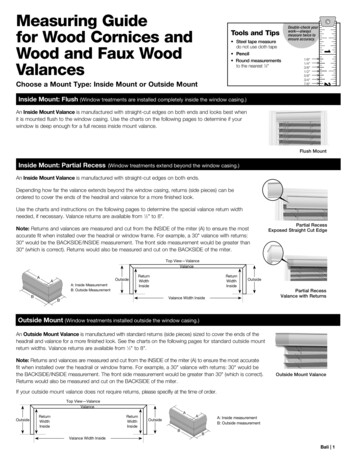
Transcription
Hints, tips and strategies to turnyou into a golf betting winner.* Plus industry insider secrets andprofessional pointers to put youone step ahead of the bookies.Page 1
ContentsSection 1: How does golf betting work?(i)When are tournaments played?(ii)Where are tournaments played?(iii)What is the "Tournament Winner" market and how does it work?(iv)What are "3-Ball" bets?(v)What are “2-Ball” bets?(vi)What is a "dead-heat" and how does this affect your payout?(vii)How are bets on the “Round 1 Leader” market settled?(viii)What is the “Top 5” “Top 10” or “Top 20” market?(ix)What are “72-hole match” bets?(x)What are “Top Nationality” bets?(xi)What does the term betting “In-Play” mean?(xii)How to follow the weekly tournaments and get results?Section 2: How does the Golf Insider service work?(i)What if you’re new to golf betting and have never placed a golf betin your life (ii)Or you’ve never placed any sports bets before here’s what to do(iii)How to receive the Golf Insider's Tournament Winner bets duringyour membership(iv)What exactly is the “OVOM” and why it’s important(v)What bookmakers are recommended for placing the bets(vi)How many bets are sent out for each tournament?(vii)When are the bets sent out?(viii)How are the bets staked?Page 2
Section 3: Golf industry insider Q&A’sFour leading industry insiders share their personal secrets andprofessional golf betting pointersSection 4: In-depth Q&A with the Golf Insider (updated)After an original Q&A session in late 2017, this is a full length, updatedinterview with the Golf Insider himselfSection 5: Golf terminologyJust in case you don’t know your sand wedge from your 9-iron, yourhook from a slice, or your Driving Accuracy from your GIR stats here’sa glossary of golf-related termsPage 3
Section 1: How does golf betting work?(i) When are tournaments played?99% of golf tournaments are played over four days. They start on Thursday and finishon Sunday.Very occasionally they go Wednesday to Saturday, or Friday to Monday.They are played over 72 holes, made up of four rounds of 18 holes, each round playedon a separate day.Typically the schedule is.Round 1 (Thursday), Round 2 (Friday), Round 3 (Saturday) and Round 4 (Sunday).Sometimes bad weather will affect a tournament. Poor conditions can make them runover into an extra day, or they can be shortened, and reduced down to just two orthree rounds. But the vast majority go the full distance of 72 holes.And if players are tied for 1st place after the 4 rounds are completed, then a play-off isused to determine the winner.This tends to be a “sudden death” shoot-out, with those golfers tied for the top spotplaying extra holes until one player shoots a lower score than his opponent(s) - andso is the winner.(ii) Where are tournaments played?Professional golf is played worldwide over a season which runs from one year to thenext. Bar a couple of weeks around Christmas/New Year, it's a 365-days-a-year sport.The two biggest circuits, or “golf tours”, where the world’s best players spend most oftheir time, are the European Tour and the PGA Tour in America.The European Tour actually stages events all over the world (Asia, Africa, Australiaand even South America) but the majority of its tournaments during the year are heldin Europe.The PGA Tour stays almost exclusively within the United States and events are held allover the country. California to Florida, Hawaii to New York.There are also joint tournaments which the tours "co-sanction" like the four Majors(the US Masters, US PGA Championship, US Open, and the Open Championship) andthen various other events which are held with other, smaller tours in Australia, SouthAfrica and Asia.Page 4
(iii) What is the "Tournament Winner" market and how doesit work?This is the main betting market offered by bookmakers for any golf tournament.Basically, you're trying to find (and then bet on) the golfer who wins the whole event(shoots the lowest score over the 72 holes).Bookmakers offer odds on this market, and refer to it as either the "TournamentWinner" or "Outright" or "Winner" market.Most tournaments start with around 150 players in the field. This is then reduced afterthe halfway cut to just 60-70 golfers.And just to explain what is meant by the “halfway cut”.To increase the element of competition, and to ease congestion over the weekend,after two days (or 36 holes) the leading golfers qualify to play the final two rounds,and the stragglers are eliminated.The cut-off point is based on a fixed number of players. For example, only the top 60players qualify ("make the cut" as it's known) with anyone from 61st place and belowsaid to have “missed the cut" - and in the results of tournaments you'll see thisabbreviated and written as “MC”.Bets are settled on the final scores, after all four rounds are completed. Or, in thecase of weather interruptions, it usually requires a minimum of 2 rounds, or 36 holes,to be played before the tournament winner is decided (although should this happensome bookmakers will differ from others in how they settle-up).If your player misses the cut, your bet loses.Now if you’re familiar with, say, horseracing you should understand the concept of“each-way” betting.And golf is no different.So if you back a player "each-way" then for you to get paid out they must finish in the"each-way places".As shown with the screenshot below from the Bet365 website, the standard terms formost bookies when it comes to the Tournament Winner or Outright market are ¼ ofthe odds for the first 5 places on the final leaderboard.This also includes the scenario when your player is tied for 5th place with a number ofother golfers.And if several players tie for 5th then "dead-heat rules" will apply – and if you read onthrough this guide then you’ll see a full explanation of how a dead-heat is settled byPage 5
the bookmakers.So this is a typical example of what you’ll see on a bookmaker’s website Sometimes bookmakers will also offer enhanced each-way terms. These can includepaying out on the first 6, 7 or even 8 places in the market.Two further things to note Until recently Betfair didn’t have an each-way market on their exchange for golftournaments. This meant to create an each-way bet on Betfair you needed to splityour stake in half and place an each equal share on the Tournament Winner marketand the Top 5 Finish (like you still can do on Matchbook, for example).But now you will see more and more tournaments on the exchanges that do offerstandard each-way terms.Also if you back in the "win-only" market then you might get bigger odds, but yourplayer must come 1st for you to collect. Nothing else will do!So make sure when you place your bet, you’re backing the golfer in thecorrect market.It’s a very easy mistake to make and there’s nothing worse than thinking you’vebacked a winner only to find that instead of seeing a nice win-bonus being paid intoPage 6
your account, you’re actually looking at a debit!(iv) What are "3-Ball" bets?During the first 2 days (or rounds) of a tournament, the field is split into mini-groupsof 3 players, known as "3-Balls". And to avoid a big queue on the 1st tee when theevent starts, and to allow for more TV coverage, these groups begin their roundsroughly 10-12 minutes apart.This means when you look at a tournament’s Round 1 3-Balls, you’ll see start timesnext to each 3-Ball (10:15, 10:27 etc).So with a 3-Ball, you’re placing a bet on which of the 3 golfers in the group will shootthe lowest score over the 18 holes played on that day (i.e. one completed round).Now there are some specific rules which apply to 3-Ball betting.If all the players who comprise a 3-Ball don’t all tee-off together - for example if oneof them doesn’t start through injury - then your bet is void with your stake returned.And this still stands if one player is replaced by another golfer there might still be 3players in the group, but it’s not the same 3 as those quoted in the odds when youplaced your bet. Also, all 3 players must complete the 1st hole for bets to be valid. If,for whatever reason, this doesn’t happen it’s a void bet and your money is refunded.And it's worth pointing out as well that "dead-heat rules" apply for 3-Ball betting and,just the same as Tournament Winner bets, your bookmaker will have their own ruleson how dead-heats are settled. And there’s more on dead-heats in a moment!But first this screenshot is taken from Ladbrokes website for the Abu Dhabi HSBCChampionship and shows the 3 players in the 3-Ball (Danny Willett, Dustin Johnson &Henrik Stenson) and their respective odds 3/1, 11/8 & 11/8.Also you’ll notice the start date (Thu 19/01 or Thursday, January 19th) andcrucially the start time (03:40). So this market will be refered to as the Round 103:40 Round 1 3-Ball.Page 7
One final point to mention is this not all bookies offer odds for every single 3Ball group.You’ll find some of the 3-Balls will only be available with certain bookies.This is because almost all firms like to offer odds on the televised groups, or thosefeaturing the top players. But the groups with lesser known golfers, away from thespotlight, don’t always get full market coverage.Bookmakers either find them harder to assess and to accurately price-up (which couldcost them money!) or they simply aren’t worth the trouble as punters don’t take anyinterest in betting on unknown players.(v) What are “2-Ball” bets?Following on from the example of the 3-Ball market, with a 2-Ball the key difference –and the most obvious one! - is that there are only 2 players competing. So you haveone less opponent to worry about.Usually you will only find 2-Balls in regular tournaments after the halfway cut hasbeen made and the field of 156 starters is reduced to just 60-70 for the final tworounds.And so to avoid congestion, and also to spread out the field for the benefit of TV, theplayers are split into groups of 2, rather than 3, players.2-Ball bets are settled in the same way as 3-Balls, but with one main difference.In a 3-Ball, if your player ties with another for the best score of the group (they bothshoot 72, or 67 or 76) you’ll be paid out according to dead-heat rules. And anexplanation of this follows.But in a 2-Ball bookmakers will quote prices on the “tie”. So if you back Player A tobeat Player B and they both go round in 70, then your bet will lose.Now there are ways around this Firstly, in a 2-Ball you can specifically back the tie (both players to shoot an identicalscore), often at big odds, which you can’t do in a regular 3-Ball.This screenshot below is taken from the BetVictor website and shows the odds for aRound 4 2-Ball in the Career Builder Challenge on the PGA Tour.It was played at 16:50 Sun 22 Jan (or on Sunday, January 22nd at 16:50) and itinvolved two European players Francesco Molinari from Italy and the English golfer,Paul Casey.Page 8
You could have backed Francesco Molinari to win at 11/10 Or Paul Casey at 1/1 or the “tie” at 15/2.This is the key difference between this 2-Ball and the previous 3-Ball example.You can back a 2-Ball to finish as a draw (or a “tie”), if you think both players willshoot the same score over the 18 holes.Secondly, another workaround for these bets This is where bookmakers offer “tie no bet” for the 2-Ball. This means if both playershit the same score you’ll get your stake refunded in full.Because it’s offering you the chance of your money-back, this “tie no bet” price willalways be shorter than a straight win bet but you might prefer this route if, bychance, both players just happen to post the same number for their 18 holes.(vi) What is a "dead-heat" and how does this affect yourpayout?OK, let's begin by explaining a dead-heat as you'll come across this term in bothRound 1 3-Ball betting and in the Tournament Winner market.In a Round 1 3-Ball, a dead-heat is when two players finish with the same score fortheir round so you might see the three players who make up a 3-Ball shoot scores of71, 71 and 75 respectively for their 18 holes.Page 9
The two players who scored 71 are the joint winners of the 3-Ball and are settled bythe bookmakers as a “dead-heat”.This means you get paid out to half your original stake at the full odds why?Because what the bookmaker is having to do is to pay out on two winners, not one.So let's say you had 50 WIN at 2/1 on one of the players who shot 71.Your payout would be 25.00 (half your original 50 stake) at 2/1 a 75.00 totalreturn, minus your original 50 stake a profit of 25.00.And please note it’s half your stake that is used for the dead-heat, not half the odds.There’s a big difference!Turning to the Tournament Winner market.You might see a winner post a score of 12-under-par for his 72 holes, with the playersfinishing in 2nd, 3rd and 4th place ending up on 11-under, 10-under and 9-under-par.But then you get three players all tied for 5th place (the last each-way payout place)as they all finish on 8-under-par. Something like this.1stPhil Mickelson-122ndRory McIlroy-113rdDustin Johnson-104thAdam Scott-9T5thIan Poulter-8T5thLouis Oosthuizen-8T5thJordan Spieth-8Poulter, Oosthuizen & Spieth are sharing the final EW place and so, like in theexample of the Round 1 3-Ball, they'd be settled as a “dead-heat”.And if you'd had 5 each-way on Ian Poulter EW at 80/1 you'd get a third of the EWpart of your stake ( 5) settled at the full place odds.Why a third?Because there are 3 players sharing one place and the bookmakers have to pay outon all 3 of them.Same goes if it's four players, you’d get paid out to a quarter of your stake, fiveplayers and it'd be a fifth of your stake and so on.To calculate your return on Poulter the standard each-way terms, as we know, are¼ odds for the first 5 places.Page 10
So your payout would be 1.67 (a third of 5 - the place part of your EW bet) paid outat 20/1 (¼ of 80/1) which would equal a return of 35.07, minus your original 5 EWstake (a total
most bookies when it comes to the Tournament Winner or Outright market are ¼ of the odds for the first 5 places on the final leaderboard. This also includes the scenario when your player is tied for 5th place with a number of other golfers. And if several players tie for 5th then "dead-heat rules" will apply –
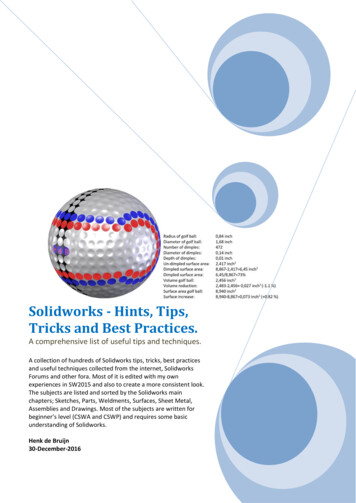
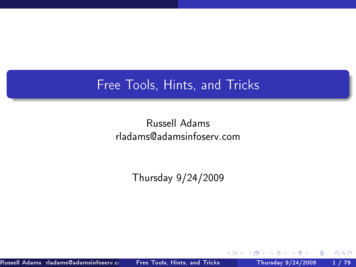
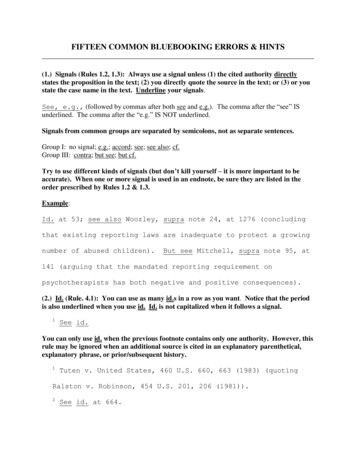

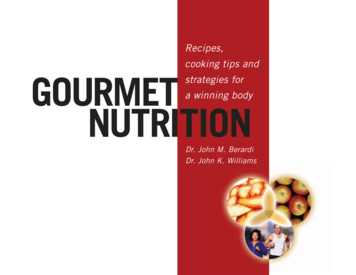



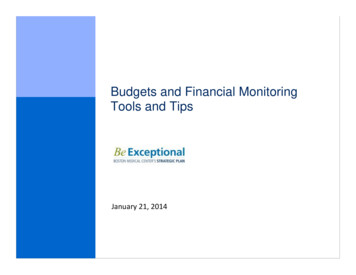
![[IV‐ADV‐9‐A] Tips and Tricks for Payroll and Human Resources](/img/9/tips-and-tricks-payroll-and-hr.jpg)
